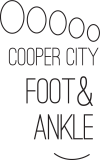Pediatric Heel Pain
Sever disease (Calcaneal apophysitis) is painful irritation and inflammation of the apophysis (growth plate) at the back of the calcaneus (heel bone), where the Achilles tendon inserts. In a child, the bones grow from areas call growth plates. The growth plate is made up of cartilage, which is softer and more vulnerable to injury than mature bone. The condition is most often seen in physically active boys and girls between the ages of 8 and 13 years and is the most common cause of heel pain in this age group. It is most commonly seen in soccer, basketball and gymnastics. Approximately 60% of Sever disease is bilateral.
How it occurs
Sever disease is caused by repetitive tension and/or pressure on the growth center. Running and jumping generate a large amount of pressure on the heels. Tight calf muscles are a risk factor because they increase the tension on the growth center. The condition can also result from wearing shoes with poor heel padding or poor arch support.
Signs and symptoms
The most common complaint is pain in the heel. The pain usually occurs during or after activity (typically running or jumping) and is usually relieved by rest. The pain may be worse with wearing cleats. The pain may limit your child’s activities and when severe, may cause a limp.
Diagnosis
Sever disease is diagnosed based on your doctor’s physical examination of the lower leg, ankle and foot and review of your child’s symptoms. If the diagnosis is in question, the doctor may order x-rays to evaluate for other injuries that may be causing the heel pain. In Sever disease, x-rays are normal.
